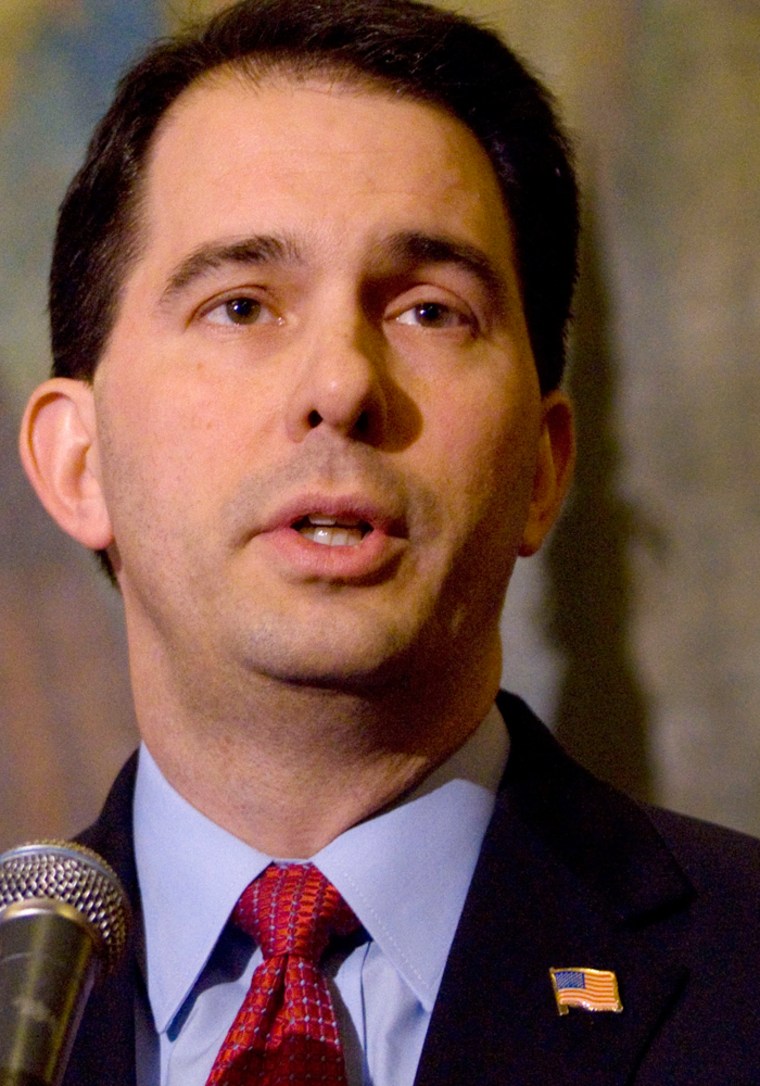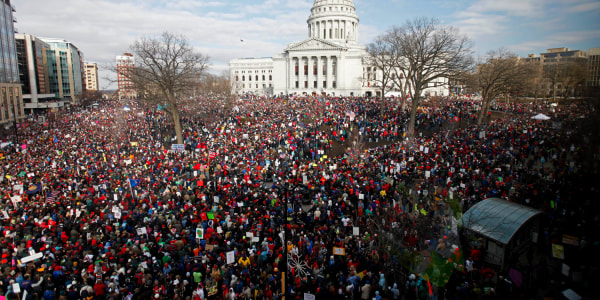After focusing for weeks on his proposal to strip public employees of collective bargaining rights, Gov. Scott Walker on Tuesday presented his full budget proposal — a plan that cuts $1.5 billion in aid to public schools and government but avoids any tax or fee increases, furloughs or widespread layoffs.
Walker said the cuts could be paid for in large part by forcing government employees to pay more for their pension and health care benefits. But his proposal to do that — and to eliminate most collective bargaining — remains in limbo after Senate Democrats fled the state to prevent a vote.
"This is a reform budget," Walker said in prepared remarks. "It is about getting Wisconsin working again, and to make that happen, we need a balanced budget that works — and an environment where the private sector can create 250,000 jobs over the next four years."
Assembly Democrats refused to stand and greet the governor. His plan also drew derision from others facing cuts.
"It feels like we're announcing a going-out-of-business sale," said state Rep. Cory Mason, a Democrat from Racine who criticized Walker's proposed cuts to education.
Walker's budget places "the entire burden of Wisconsin's budget shortfall on our children, our most vulnerable citizens in need of health care and long-term care, and our dedicated public employees," said Robert Kraig, director of the consumer advocacy group Citizen Action of Wisconsin.
Doing so is Walker's "own value choice, not an economic necessity forced on him by others," Kraig said.
Walker's proposals have stirred a national debate over public-sector unions and drawn tens of thousands of protesters to the Capitol for three weeks.
The governor released his two-year budget in part to support his argument that public worker concessions are essential to confront a projected $3.6 billion shortfall.
"Our state cannot grow if our people are weighed down paying for a larger and larger government, a government that pays its workers unsustainable benefits that are out of line with the private sector," he said. "We need a leaner and cleaner state government."
By eliminating most collective bargaining, Walker says, state agencies, local governments and school districts will have flexibility to react quickly to the cuts he outlined during a joint session of the Legislature convened under heavy security.
Even though Walker isn't ordering immediate layoffs, his budget will put tremendous pressure on schools and local governments, which will be asked to shoulder huge cuts without raising property taxes to make up the difference.
Walker's budget includes a nearly 9 percent cut in aid to schools, which would amount to a reduction of nearly $900 million. The governor also proposed requiring school districts to reduce their property tax authority by an average of $550 per pupil.
Since 1993, the state's property tax limits have gradually risen to reflect increasing costs, and reducing them makes it more difficult for schools to make up the lost money.
Additionally, cities would get nearly $60 million less in aid, an 8.8 percent cut, while counties would lose over $36 million, a 24 percent reduction. They would not be allowed to increase property taxes except to account for new construction.
Walker estimates that his controls on property taxes would save $736 over the next two years for the owner of a home valued at the median price of $161,300.
He's also proposing a $500 million cut to Medicaid, which would be achieved through a number of changes that include increasing co-pays and deductibles and requiring participants in SeniorCare to be also be enrolled in Medicare Part D.
Walker asked for $82 million in tax cuts, including an expanded exclusion for capital gains realized on investments made in Wisconsin-based businesses. The Legislature previously approved more than $117 million in Walker-backed tax cuts that take effect later this year.
The budget also cuts funding at most state agencies, by 10 percent, except for salary and benefits.
He would permanently eliminate 735 positions that have been vacant for more than a year. Some other jobs could be cut as Walker moved to consolidate juvenile prisons and make other changes, but no widespread layoffs were envisioned. State spending over the next two years would go up a paltry 1.3 percent.
Walker also targets many law changes passed by Democrats in recent years.
He proposed undoing changes made by Democrats to allow prisoners to earn time off their sentences for good behavior. Instead, Walker would reinstitute a truth-in-sentencing law that he sponsored while a member of the Assembly.
He would also no longer allow children of illegal immigrants who attend state universities and colleges to pay in-state tuition.
As expected, Walker proposed removing the flagship Madison campus from the University of Wisconsin system, leaving 12 other four-year campuses and 13 two-year universities. The system has been ordered to study a similar move for the Milwaukee campus.
Slideshow 68 photos
The battle over collective bargaining rights in Wisconsin
Over the next several months, the Legislature will review Walker's budget and offer revisions, with the expectation that lawmakers would vote by early summer.
It wasn't clear when Senate Democrats would return to take up his collective bargaining proposal. Walker said in his speech their inaction could lead to thousands of layoffs in order to balance the budget.
Republican Senate Majority Leader Scott Fitzgerald met Monday in Kenosha with some of the missing Democrats and discussed terms under which they could return. Fitzgerald said they didn't talk about changing the bill, which he said would not be altered.
He would not say who was at the meeting or how many were there, but no agreement was reached.
"We keep taking," Fitzgerald said.
Numerous compromises designed to end the stalemate have been floated by unions, Democrats and even a Republican senator but none has gained traction.
In addition to the bargaining rights changes, the bill designed to fill this year's projected $137 million deficit also called for refinancing state debt to save $165 million. But the deadline to get that done was Tuesday.
Walker has threatened to make more cuts after the deadline but has not outlined what those would be.
Polls indicate national public opinion favors unions in the dispute, but Walker has been resolute.
A Pew Research Center poll released Monday found 42 percent of adults surveyed nationwide sided with the unions and 31 percent sided with Walker. That poll of 1,009 adults had a margin of error of plus or minus 4 percentage points.
The latest New York Times-CBS poll found Americans oppose efforts to weaken the collective bargaining rights of public employee unions by a margin of almost two to one — 60 percent to 33 percent. The nationwide telephone poll of 984 adults had a margin of error of plus or minus three percentage points.
Just a quarter of adults in the poll considered public employees' benefits and pay to be too high, while about the same share believed they are too low. About 36 percent say they are about right.
Majorities oppose cutting public employee benefits or pay in order to reduce state budget deficits or taking away some collective bargaining rights from public employee unions.
Some of the opposition may stem from skepticism about the state government's motivations. Forty-five percent of those who responded to the New York Times-CBS poll believe states want to reduce employee benefits to help ease the deficit, but nearly as many (41 percent) say their aim is to weaken the power of unions.
Both polls were conducted Feb. 24-27.

